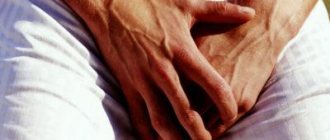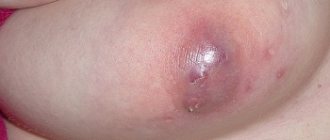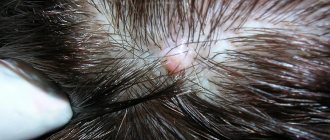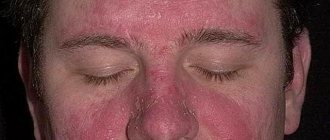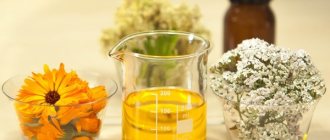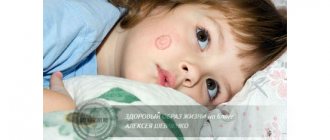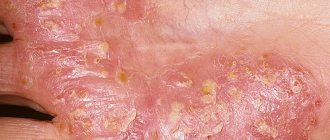Ulcers on the skin are a common reason for visiting dermatologists. Most often, the doctor prescribes treatment with antibiotics, ointments that accelerate the maturation of boils, or surgical removal of the abscess with drainage of the wound.
Photo 1 - Furuncle
In most cases, a boil on the back, on the leg or on the cheek can be treated at home, after first agreeing on a plan of action with a specialist.
Photo 2 - Furuncle on the back on the back
However, abscesses that form on mucous membranes or especially dangerous areas with a closely located network of blood vessels, for example, in the nose, on the eye or even in the ear, etc. need to be treated according to a slightly different scheme, so a visit to the hospital cannot be avoided.
Photo 3 - Furuncle on the eye
An abscess on the face can spoil the appearance not only during its maturation. If treated incorrectly, after opening it, sometimes an unsightly scar formed by scar tissue remains.
Photo 4 - Furuncle on the face
People whose skin is prone to the formation of colloidal scars should be especially careful. If such an abscess occurs in a child, the situation is further complicated by the inability to prevent scratching and touching the inflamed skin with hands. An abscess on the nose or under the arm will bring additional discomfort due to the particular pain and sensitivity of the skin.
Photo 5 - Abscess on the nose
In addition, the armpit area is subject to constant mechanical stress, contact with skin or clothing, which will become another obstacle to normal healing.
Photo 6 - Boil under the armpit
Features of furunculosis
Among the people, furunculosis has another name - boil.
The disease belongs to pathologies of a purulent-necrotic nature. The disease begins with damage to the hair follicle and surrounding connective tissue. At the site of the future boil, an inflammatory node is first formed, which surrounds the hair follicle.
The development of furunculosis is caused by the penetration of a staphylococcal infection into the body. The disease is easily diagnosed. A dermatological lesion occurs on the skin. The presence of an inflammatory process is detected using a blood test and bacterial culture of skin elements. A dermatologist treats furunculosis.
Causes of occurrence and growth
Most often, boils overwhelm the body during periods of severe stress, reduced immunity, after a series of colds or operations. In women, this problem can worsen during the premenstrual period, when the body's defenses are at zero.
An infection called Staphylococcus aureus enters the hair follicle or pore and causes inflammation there. This can occur on any part of the body, but most often occurs in the back, forearm, neck, and ears. Suppuration occurs, if the body does not have the strength to fight the source of inflammation, then a purulent abscess forms.
Is Staphylococcus aureus always the cause of furunculosis? No, sometimes this phenomenon is caused by other pathogenic bacteria that overcome the protective skin barrier through wounds and microtraumas. But in 70% of cases the cause is staphylococcus.
Causes of furunculosis (harmful bacteria entering the body): rarely washing hands after going outside, eating dirty vegetables and fruits, playing with dogs and cats, working in the ground.
If the body’s immunity and resistance are at a high level, then suppuration will not occur, and the person will not even know about a possible infection.
Symptoms of furunculosis
The main symptom of the disease is the manifestation of the inflammatory process. At the site of the lesion, the skin becomes red and swelling occurs. Then a pustule with a purulent head forms, which begins to hurt with slight pressure.
The disease most often develops in people who have a weakened immune system:
At the first stage, purulent fluid appears near the follicle. The hair follicle is completely immersed in pus. The surrounding tissues become inflamed, red and swollen.
Over time, inflammation spreads to the sebaceous gland. As a result, it becomes bump-like, its top rising above the rest of the skin surface. To the touch, the affected area feels like a hard cone-shaped node. As a result, an attempt to touch the site of inflammation is accompanied by pain.
The appearance of a boil on the neck or face is accompanied by severe swelling. The inflammatory infiltrate accumulates over four days. When pressed, purulent fluid is released from the top of the boil.
At the first stage there is little purulent content. With further squeezing, a purulent core will appear, which is a distinctive feature of furunculosis. When the rod is removed from the wound, a small amount of pus mixed with blood will be released.
After the rod is rejected, the disease will gradually begin to subside. The symptoms will gradually disappear, and a wound will remain at the site of the lesion. It may still contain purulent fluid and necrotic masses for some time. During the healing phase, it is important to keep the wound clean. The opened boil should be treated with antiseptic ointments to prevent the disease from progressing to the chronic stage.
Important! If one boil has formed on the body, then there may be no signs of inflammation. In the case of multiple lesions, a person’s general condition worsens and the level of performance decreases.
Indications for the use of antibiotics
The main and effective method of getting rid of boils is taking antibiotic drugs.
A dermatologist prescribes them for treatment in the following cases:
- The patient developed numerous foci of inflammation.
- Most boils are localized on the neck and head.
- Furunculosis caused complications, as a result of which the lymph nodes became inflamed.
Antibiotics are also prescribed to patients whose disease has become chronic. In addition to this group of drugs, the patient is prescribed immunostimulating agents and vitamin complexes. For furunculosis, physiotherapeutic procedures and dietary nutrition are indicated.
Homeopathy and vitamins
Homeopathic remedies are prescribed for the chronic form of the disease both as therapy and as prevention. Homeopathy has virtually no contraindications. For boils, compresses, extracts and extracts from calendula, yarrow, arnica, plantain, and chamomile are used.
Vitamin therapy is designed to increase immunity and the body's defenses. A high-quality vitamin and mineral complex is an excellent prevention of the formation of boils in the future. Dermatologists often prescribe brewer's yeast for furunculosis. They contain the entire complex of B vitamins and relieve skin diseases.
Also excellent vitamins for furunculosis are “Supradin” and “Supradin Kids” (for kids). They contain the daily required amount of not only vitamins, but also minerals. The effervescent form of the tablets is completely absorbed by the body. People's reviews of Supradin are mostly positive.
Contraindications
Antibiotics should not be taken in the following conditions:
- Intolerance to antibacterial drugs.
- Pregnancy and breastfeeding period.
- Diagnosed bronchial asthma.
- Liver and kidney diseases.
- Intestinal diseases.
- Fungal skin lesions.
- Open tuberculosis.
- Problems with the heart and the process of hematopoiesis.
Furunculosis is a disease that cannot be treated on your own. Only a dermatologist, after laboratory tests, will be able to make the correct diagnosis and begin treatment. The doctor, based on the individual characteristics of the patient, will select the dosage and treatment regimen. When prescribing therapy, he will take into account contraindications and prevent the development of complications.
Antibiotics for the effective treatment of furunculosis
With proper treatment, you can get rid of a boil in 10-15 days. The most effective method of getting rid of boils is taking medications that belong to the group of antibiotics.
For therapy, a dermatologist can prescribe medications from the following subgroups:
- Penicillins are effective antibiotics whose action is aimed at destroying gram-positive bacteria. Among the products in this category, the most popular are Bicillin, Ampiox, Ampicillin, Amoxicillin.
- Cephalosporins are antibiotics used to prevent the spread of infection and its further penetration into the deeper layers of tissue. The most commonly prescribed drugs are Cefuroxime, Cefazolin, and Cefipime.
- Macrolides - differ from the first two subgroups. They are recommended to be taken when, when a boil ripens, a person experiences a febrile state or high temperature. These drugs are able to stop the inflammatory process in a short time and do not harm the intestinal microflora. Antibiotics of this group should be used with caution in patients suffering from renal or hepatic dysfunction. The reason lies in the ability of drugs to accumulate in the body. Among the macrolides, the most common are Macropen, Erythromycin, Azithromycin and Sumamed.
An antibiotic for the treatment of furunculosis should only be chosen by a dermatologist. Complex therapy includes the use of medicinal ointments, injections and oral administration of tablets.
Stages of treatment of boils
Purulent formations are treated in several stages under the supervision of a doctor.
After the abscess has matured, it should be opened surgically. Under no circumstances should the boil be squeezed out with your fingers. There is a huge risk of introducing another infection into the wound and causing complications. The surgeon injects the site of inflammation with an antibiotic solution with novocaine. Anesthesia relieves pain and stops the development of the purulent process.
Often people turn to doctors with the boil stage when an abscess has already begun and inflammation has led to the destruction of adjacent tissues. In this case, the surgeon will open the abscess and completely clean out the pus. Treat the open wound with antibacterial ointment and apply a sterile bandage.
If there are a large number of recurrent ulcers on the head and neck, the doctor prescribes tablet antibiotics: Lincomycin, Cephalexin, Amoxiclav, Fuzidin sodium.
Use of antimicrobial ointments
Antibacterial ointments are used during the period when the abscess is opened. The bandage is soaked in ointment and applied to the open wound.
Among ointment preparations, Levomekol, Fucidin, Bactroban, Baneocin are often prescribed. Tetracycline ointment has a wide spectrum of action, which is used not only for the treatment of boils.
Important! A warming compress should not be applied to the boil. Heat accelerates the spread of the purulent process, which can spread to adjacent tissues. It is also forbidden to put pressure on the sore area. Mechanical impact on the boil will cause the inflammatory process to accelerate and affect new areas of the skin.
Immunomodulators for furunculosis
Boils occur as a result of a bacterial attack on an immune-compromised body. Therefore, taking immunostimulating agents is part of the comprehensive treatment of furunculosis. The action of the drugs is aimed at increasing the protective functions of the body. In such cases, the doctor may prescribe Immunoglobulin, Polyoxidonium or Galavit.
Vitamin complexes
Taking vitamins will also help increase the body's strength necessary to fight the disease. Vitamin therapy includes retinol acetate, thiamine, riboflavin, ascorbic acid and many others.
Physiotherapy
For furunculosis, dermatologists often recommend physiotherapeutic procedures to patients. The most effective are UHF therapy, ultraviolet irradiation, electrophoresis using antimicrobial agents, baths with the addition of potassium permanganate, ozone therapy and others.
What drugs are used?
Many remedies have been developed for the treatment of furunculosis.
The inflammatory process is a complex combination of internal and external factors; to eliminate it, you need to act from different angles. The type of therapy depends on three components: stage, size, cause. Furunculosis: treatment with the following drugs:
- Antibacterial drugs have a detrimental effect on living cells - beneficial and harmful microorganisms. Quickly and effectively suppresses the pathogen - staphylococcus.
- Anti-inflammatory. Any medication from this group quickly reduces and stops inflammation. In the vast majority of cases, the doctor prescribes the medicine in the form of an ointment. It is applied pointwise to the boil, which accelerates the absorption of active substances. Popular drugs: Rescuer, Diclofenac, Dimexide. Tablets may be prescribed - Nimesulide, Voltaren, Aspirin (acetylsalicylic acid), etc. They provide an analgesic effect and alleviate the patient’s condition.
- Antiseptic. They prevent relapse, stop rotting, disinfect, kill germs. For the treatment of boils, the following are used: potassium permanganate, Fukortsin, Betadine, Magnesia, Vinylin, Chlorhexidine, Baneocin ointment, Furacilin, salicylic acid, Chlorophyllipt, Miramistin.
- Antihistamine. Reduces tissue swelling.
- Preparations to strengthen the immune system. Bacterial infection attacks more often at times when the body's defenses are weakened. An immunomodulator will help strengthen it. To treat furunculosis, it doesn’t matter what it is - a capsule, a drop or a tablet, the main thing is the result. The duration of the course depends on the patient's condition. A good therapeutic effect is given by: Galavit, Immunal, Timalin, Polyoxidonium. Lykopid helps to increase local immunity.
- Vitamins and homeopathy act as aids in the chronic form of the disease, for preventive purposes. The homeopath selects herbs and describes the scheme for their use. When treating furunculosis with homeopathy there are no contraindications; it can be used even if the patient is a child. Vitamin preparations are taken in courses; they must contain substances beneficial to the skin.
The doctor conducts an examination and then makes recommendations for treatment.
The first stage of the disease involves treatment with alcohol solutions and antiseptics: Miramistin spray, medical diluted alcohol (diluted with boiled water), Chlorhexidine, Furacilin solution. Apply gently to the boil, working around the area.
After self-opening, disinfection is carried out. A compress is applied, under which there is a drug with anti-inflammatory and disinfectant action.
In the chronic course of the inflammatory process, it is important to pay attention to strengthening the body. If the cause is a helminthic infestation, Dikaris and its analogues are prescribed. If the intestinal microflora is disturbed, probiotics are needed - Lactofiltrum, Diflucan. If the protective mechanisms fail, immunomodulators, vitamins, herbal infusions, and preparations are prescribed.
Some traditional medicine recipes are very effective for treating boils.
At home, you can prepare special ointments from natural ingredients that promote the maturation and healing of boils:
- Onion ointment – 2 large onions need to be baked in the oven until soft. Then you should chop the onion to a pasty state. Take half a bar of laundry soap and grate it on a fine grater. Mix both components and apply to the boil, bandage and keep for 12 hours, then replace the compress with ointment. In a day and a half, the abscess should burst.
- An ointment made from several ingredients - grate a quarter of a bar of laundry soap, add 1 tablespoon of olive oil, natural honey, rye flour. Pour a glass of boiling water over everything and cook for 2 - 3 minutes. Put 25 g of wax into the mixture, stir until it melts. The ointment is applied to the affected area twice a day, covered with a sterile bandage. The medicine promotes the maturation of the abscess.
- Wax-based ointment - first you need to hard-boil a chicken egg, you only need the yolk. Corn, linseed or olive oil (3 tablespoons) are slightly heated over heat, crushed yolk and 50 g of finely grated beeswax are added. After boiling, the ointment is ready for use.
Read more about how to quickly treat a boil at home here.
Some people choose ready-made pharmacy ointments to treat boils, while others trust the advice of traditional medicine. In any case, you should consult your doctor regarding the use of medications.
Each ointment is effective at a certain stage of boil development. In addition, there are contraindications and side effects from the use of medications. Only a qualified specialist can take into account all the nuances.
In the treatment of abscesses, purulent pimples and boils, ichthyol ointment and Vishnevsky ointment are still in demand among patients, and their prescription by doctors is not inferior in frequency to modern means. And although ichthyol ointment and balsamic liniment according to Vishnevsky have an unpleasant odor and greatly stain clothes, their use speeds up the opening of abscesses and promotes rapid healing of the resulting wounds.
Balsamic liniment according to Vishnevsky, or Vishnevsky ointment, was created by a military doctor in 1927 and since then has been successfully used for many purulent formations on the skin.
Ichthyol ointment has been used since 1883, but is still in demand among doctors.
Among the common features of these two ointments will be:
- Low price, they can be bought at a pharmacy for 110-140 rubles.
- The general area of application is that they are classified as antiseptics and successfully fight bacterial infections.
- The drugs are used only for external use.
- High efficiency with a minimum number of side effects and contraindications.
Only the composition of the drugs will be different.
According to Vishnevsky, Balsamic liniment contains only three components. The main active ingredient is xeroform powder (30 mg), which not only disinfects, but also accelerates tissue regeneration and helps eliminate the inflammatory process. Xeroform penetrates bacterial cells and disrupts protein synthesis in them, which leads to suppression of the development and growth of bacteria.
Birch tar (30 mg) in this composition acts as a preservative; it enhances the antiseptic effect of xeroform (bismuth tribromophenolate), and castor oil (up to 1 g) promotes the penetration of active components deep into the tissues, and additionally warms them up, accelerating the flow of blood to the affected area.
Liniment can be applied to a clean cloth, gauze, and in the field even to moss. It is not afraid of cold and heat, practically does not spoil, and the product can be frozen. The only precaution is to store the medicine in a place protected from light (it is available in tubes or dark glass bottles).
Instructions for use prescribe its use for:
- frostbite;
- ulcers in the granulation stage;
- wounds;
- abscesses;
- carbuncles, boils.
According to the instructions for use, apply the drug in a thin layer to the affected area, covering an area (up to 1 cm) of healthy skin at the edges. If necessary, apply a bandage soaked in liniment to the wound.
The dressing is changed after 8 hours, each time using a new portion of ointment on clean gauze. Treatment period is up to 20 days.
When the purulent contents mature, keep the bandage until the abscess is opened. To speed up the opening of acne, purulent pimples and wen, the product is applied at night in a thin layer to the skin, covered with a bandage on top, which is fixed with a band-aid.
To speed up the release of purulent contents from a boil, the following types of ointments are used:
- Ichthyol - has anti-inflammatory, antiseptic and local anesthetic effects, used at the early stage of abscess formation. Active ingredient: ichthyol. The product is applied to the affected area of the skin 1-2 times a day. The course of treatment is determined individually. Price: 85 rubles (25 g).
- Heparin - has a local anti-inflammatory and anti-exudative effect, improves microcirculation and reduces tissue swelling. Active ingredient: sodium heparin. Directions for use: Apply a thin layer to the affected area and gently rub into the skin. The procedure must be repeated 2-3 times a day for 3-7 days. Price: 95 rubles (25 g).
- Vishnevsky ointment (or balsamic liniment) - has an antiseptic and locally irritating effect, accelerates regeneration processes. Active ingredients: tar, xeroform, castor oil. The product is used as a compress 3-4 times a day (until signs of recovery). Price: 75 rubles (30 g).
We suggest you read: Can a boil resolve without opening or does it require treatment?
In this case, it is necessary to observe the frequency of applying ointments and not to keep the compress longer than prescribed (according to the instructions).
Possible complications
An advanced disease can cause various complications, which often spread to healthy organs.
Complications of furunculosis may be the following:
- The development of lymphadenitis is inflammation of regional lymph nodes.
- Lymphangitis is inflammation of the lymphatic vessels.
- Blood poisoning.
- Inflammatory processes of the brain.
- Arthritis.
- Kidney diseases.
Complications can only be prevented by timely consultation with a doctor. Diagnostics and a properly selected treatment regimen will protect the patient from unwanted consequences.
Self-medication for furunculosis is strictly prohibited. Treatment and opening of abscesses at home is fraught with serious complications. Taking medications, dosage and regimen of use should be under the supervision of a dermatologist.
